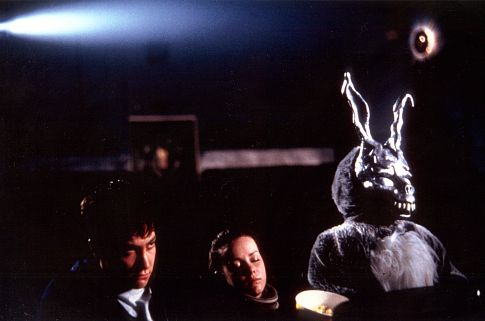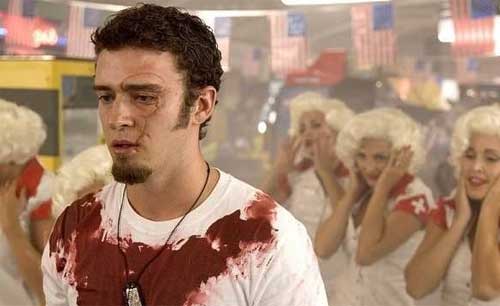Title: The Science of Sleep
Director: Michel Gondry
Released: 2006
Staring: Gael Garcia Bernal, Charlotte Gainsbourg, Alain Chabat, Miou-Miou
Plot: Stephane (Bernal) a frequent lucid dreamer, who seemingly spends as much time in his own personal dream world as he does in the real world. Having returned from Mexico to his childhood home in Paris, following the death of his father, he takes up a job at a Calendar Company believing that it will provide the outlet for his creativity he craves, while also forming a relationship with Stephanie (Gainsbourg) who shares Stephane’s overactive sense of creativity.
Review: This last week despite my best efforts I have been suffering from the darn flu that is currently going around and in between amassing a small pharmacy of flu remedies and looking for some suitable viewing while I was refusing to get out of bed, I rediscovered this film in my collection and knew that I had found my choice for this week. This weeks choice is a film which was pretty much ignored on it’s release despite receiving a lot of positive press from critics, which is only the more surprising at the time with Director Michel Gondry coming in hot after the phenomenal success of “Eternal Sunshine of the Spotless Mind” and memorable in the conscious of the movie going public, an advantage which allowed Gondry seemingly unlimited creative freedom for this project, which would also be the first film written by him, with his previous films both being scripted by the equally visionary screenwriter Charlie Kaufman probably best known for writing “Being John Malkovich” and while “Eternal Sunshine of the Spotless Mind” might have been trippy, this film would be turn out to be on a whole new surreal level.
Coming from a background in commercials and Music videos, much like equally visual directors such as David Fincher and Spike Jonze who bizarly also made the transition to feature films around the same time as Gondry did, though while they may have expanded on their earlier styles, Gondry has reminded determinedly set in his own surreal world of DIY props and dream like imagery, while frequently drawing inspiration from his own dreams and has frequently used this imagery as part of his work, which makes it only all the more sense that he would eventually make a film about dreams.
The casting is nothing short of bold, with the two leads being realativly unknowns to most movie goers, bar those with a taste for Foreign and independent cinema. Having made the pitch black “The King” a year earlier this film would be Bernal’s second film to be shot in English, having previously only being known to fans of foreign cinema for his roles in “Y tu mamá también” and the fantastic “Amores perros” this film would continue his trend for fearlessly choosing his roles, especially with a character as frenzied as Stephane. Equally inspired is the casting of the little known Gainsbourg who is equally believable as Stephanie while seemingly to genuinely believe and buy into the world which Stephane lives inside, while also being shown as the stereotypical hot art student with her personal styling and room layout, which also is hinted with the intoxicating essence of Parisian flair.Split down the middle, the film frequently switches between two worlds, the real one and the world of Stephane’s dream and more precisely “Stephane TV” his own TV show in his mind were he frequently reflects on current events happening around him, while providing the gateway into the even more surreal parts of his mind, with Gondry frequently choosing to switch between these two worlds frequently without warning, which can be a disorientating experience upon your first viewing and it’s really only on the second viewing that it becomes easier to identify the boundary lines between these two worlds, even when those lines frequently become all the more blurred as the film goes on, especially as Stephane’s dreams only grow in intensity.
This constant disorientation is only furthered by the frequent switches in the characters speaking French and English, also like the switches in reality with little or no warning, only making it more the appropriate when this is picked up by Stephane, who complains that it is making him feel “Schizophrenic”. Still Gondry somehow manages to get the audience to buy into this style of storytelling, which is highly reminiscent of French New Wave directors such as Jean-Luc Godard and from the retro opening titles onwards I found myself frequently comparing the work of the two directors, especially with both being key in furthering the progression of visionary cinema and it was interesting to see Gondry seemingly referencing Godard’s work, while also drawing inspiration from the more established visionaries like Terry Gilliam and David Cronenberg whose Spider like Typewriter from “Naked Lunch” making a surprise appearance here.
The dream sequences are truly the main selling point of this film, as Gondry lets loose with some of his most ambitious imagery to date, as he constructs elaborate sets from cardboard and polystyrene combined with heavy use of stop motion animation, while for those familiar with Gondry’s work will recognise the now all familiar giant hands which have frequently appeared at various points in his previous music videos and films to the point were they are almost as established as his other trademarks, despite having originally been born out of a frequent childhood nightmares about his hands growing to gigantic size, to the point were his mother would have to continuously rubs his hands to assure him that it was nothing more than a dream, though for such an unpleasant childhood memory it bizarre that it would feature so frequently in his work. Still frequently these sequences often do feel like an excuse for Gondry to pull out his film making bag of tricks, especially when so many scenes seem reminiscent of his earlier work.
Ultimately this would be his most ambitious film to date and also prove to be the zenith of his creativity, as the films which followed would see him gradually toning down his vision with his follow up “Be Kind Rewind” being firmly set in reality despite the heavy use of DIY props to now an almost mainstream style of film making seen with “The Green Hornet” which lacked any of Gondry’s trademark touches, though it remains to be seen how mainstream he has become as fan’s now egerly await the forthcoming “The We and the I”.
Ultimately this is a tale of doomed love and it’s sudden and abrasive ending will no doubt only further exclude it from the tastes of your average movie goer, while for those of you who like to be visually inspired by your film, there is much to enjoy, even if it does require your full attention to keep up with it’s continual switches, while only making you hope that Gondry returns to this style of film making soon






















No comments:
Post a Comment